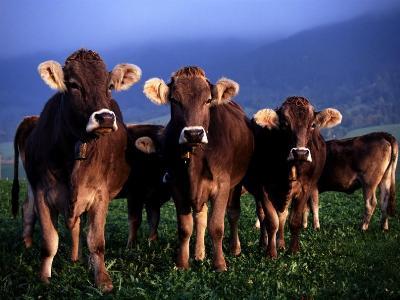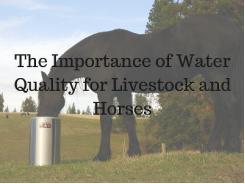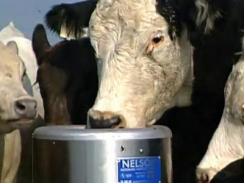Preparing Your Livestock for Cold Weather – Your Complete Guide

With the winter storm that swept through the country recently, winter came suddenly and ferociously. And even though my family has farmed for generations, we were NOT prepared. We spent several harrowing days moving animals around, rushing to the farm store for heaters, increasing feed supply, monitoring animals round the clock to ensure they were adjusting to the sudden drop in temperature, and generally running ourselves ragged. After things finally got under control, we were exhausted, the animals had all experienced some cold stress, and we spent too much money on emergency supplies.chong qi you yong chi
Hopefully this didn’t happen to you, but if it did, here are some tips to keep things running smoothly for the rest of the season and to help you better prepare for future winters.
Water
Water is the number one concern in freezing temperatures. Large livestock consume multiple gallons of water a day, and licking ice or eating snow is not only insufficient, but dangerous – body temperatures can drop quickly when the liquids consumed are below 40˚F.
Lots of livestock owners resort to heated water buckets or removable heating elements to keep water thawed. I would suggest this only as an emergency option. First of all, the largest heated buckets hold a mere 5 gallons of water, barely enough to meet the daily needs of one large animal. Those with multiple animals must resort to placing floating heating elements in large water tanks, but not only are these are hardly ever powerful enough to keep the whole tank thawed out, they are frequently knocked out or disconnected by milling animals. In either case, extension cords must be run to and fro, which not only are a headache but can also cause tripping and injury Toboggans gonflables.
By far the best option for watering in the winter is the use of automatic waterers. Through circulation or a heating element or a combination of both, automatic waterers keep water thawed and fresh for any number of animals. There are no extension cords to worry about and very little to no maintenance, a perk at a time of year when no one wants to be out doing extra work. At Nelson, our waterers are top-rated and our representatives want to help you choose the best one for your operation.
For more information about livestock waterers, visit Nelson Mfg.
Feed & Energy Requirements
As the temperature goes down, livestock energy requirements go up. That’s why, even though it may be the off-season for your performance and/or breeding animals, their winter diet requires just as much careful attention. You need to be sure your animals are taking in the energy they need to keep warm.
Most domestic livestock winter on lots of fiber. The breakdown of fiber is a metabolic process that results in long, drawn-out energy levels needed to sustain body heat. One might assume that fat, not fiber, would be better for a winter diet, but the breakdown of fat is a metabolic spike that results in muscle growth, intense performance energy, and gestational prowess. Fat is not conducive to the sustained, low-level energy livestock need to weather the winter.
On our farm, we cut fatty grains entirely and put out a round bale so the animals can munch on alfalfa all day long. Not only is this method incredibly effective in keeping their metabolic processes running 24/7, but it greatly cuts down on labor – a nice bonus in the cold winter months. If you don’t have access to a large hay supply, make sure to supplement hay rations with fiber pellets or any kind of high-fiber feed.
Shelter
In this day and age, more and more livestock owners are indulging in the luxury of heated and/or insulated barns. This is certainly advisable for birthing animals and newborns, for whom any kind of winter cold can be fatally dangerous (if you have an expecting animal and/or newborn, be sure to bed them down amply in a well-sealed barn, blanket, and run radiators as needed). But at the end of the day, as my dad always likes to say, “animals are animals”, and their best defense against the winter cold is their thick winter coat and energy-preserving behavior patterns (this is also why it’s not advisable to blanket most animals – for more information on that topic, see our previous post: To Blanket or Not to Blanket? Keeping your horse comfortable this winter
With that in mind, the best winter shelters for most livestock are simply those that keep them dry and protected from biting winter winds. In our area of the country, the wind almost always blows out of the northwest, so our shelters are all backed against the northwest and open to the southeast. Whatever the case in your area, be sure that most of the time animals have a place to escape from the cold winter wind.
Of course, there are some livestock – namely chickens and other fowl – that need enclosed shelters and heating lamps. Know your livestock, and take steps to warm any animal who displays shivering, weight loss, unusual lethargy, or underproduction.
Health Concerns
Of course, all your livestock should go into the winter season with up-to-date vaccinations and a healthy weight. Underweight animals need to be fattened up and/or kept in a barn during the cold months, because their metabolic processes are not up to speed and will not keep them warm enough. Mothers and babies also, as already discussed, need to be kept indoors and monitored closely, as they are highly vulnerable.
One of the biggest problems in the wintertime is foot health. Hooved animals can easily bruise their feet on the hard, frozen ground. Hooves can also become far too dry, causing them to peel back and break off, or in warmer temperatures can become too wet, leading to all kinds of infection and permanent damage. Last winter, we wrote an in-depth post on winter hoof health, which can be seen here: Winter Hoof Health
Animals with padded feet, such as llamas and dogs, can become lame from impacted snow. If you see signs of lameness in this type of animal, moves it indoors to allow the snow to melt out and the animal to regain its footing.
Of course, in frigid temperatures, livestock should never become wet. The most dangerous weather for livestock is cold, wet rain, which can lead to colds, fevers, the flu, severe hypothermia, and even death. If wintertime for you means cold rain or sleet, make sure your shelters are large enough to allow every last animal to get and stay dry. If you are a horse owner intent on a winter ride, DO NOT work your horse into a sweat. If you do, move him indoors after the ride to allow him to dry off before turning him back out to pasture.
Inspecting Your Livestock
Even after making all these preparations, the best way to combat the winter cold is through constant vigilance. Carefully inspect your livestock each and every day for signs of cold stress, i.e. shivering, weight loss, lethargy, and/or underproduction. On our farm, we know the chickens are too cold when their egg production goes down. We know the goats are too cold when they stop their usual frolicking. We know a calf is too cold when we see him hunched in a corner, barely moving and looking miserable. Watch your livestock. They can’t tell you, but they will show you, so watch them closely through the cold winter months. What’s more, some of my most profound experiences on the farm have been while doing my “winter rounds” – checking on everyone, petting them, snuggling against their frosty breath, and bonding in the shared experience of the cold.
Happy wintering!
Related news
Tools

Phối trộn thức ăn chăn nuôi

Pha dung dịch thủy canh

Định mức cho tôm ăn

Phối trộn phân bón NPK

Xác định tỷ lệ tôm sống

Chuyển đổi đơn vị phân bón

Xác định công suất sục khí

Chuyển đổi đơn vị tôm

Tính diện tích nhà kính

Tính thể tích ao



 Raising Livestock: How to Raise Premium Livestock for…
Raising Livestock: How to Raise Premium Livestock for…  Automatic Livestock Waterers: Preparing for Winter
Automatic Livestock Waterers: Preparing for Winter